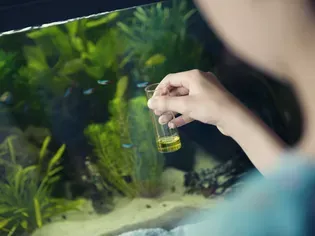Fin Rot in Aquarium Fish
Updated on 04/26/24

Fin Rot in Aquarium Fish: A Comprehensive Guide to Prevention, Treatment, and Recovery
Introduction
Fin rot is a common and often devastating disease that afflicts aquarium fish. It is caused by a bacterial infection that attacks the delicate fin tissue, leading to erosion, discoloration, and ultimately loss of the fins. Left untreated, fin rot can spread rapidly, causing severe damage to the fish and even death.
This comprehensive guide will provide you with everything you need to know about fin rot, from its causes and symptoms to effective prevention, treatment, and recovery strategies. By understanding the disease and taking the necessary steps to combat it, you can help your aquarium fish stay healthy and thriving.
Causes of Fin Rot
Fin rot is typically caused by a bacterial infection, often Aeromonas or Pseudomonas species. These bacteria are opportunistic pathogens that take advantage of weakened fish or damaged fin tissue. Several factors can contribute to the development of fin rot, including:
* Stress: Stressful conditions, such as overcrowding, poor water quality, or handling, can weaken the fish's immune system, making them more susceptible to infection.
* Injury: Physical damage to the fins, such as through biting or torn fins, can provide an entry point for bacteria.
* Poor water quality: Ammonia, nitrite, and nitrate levels that are too high or too low can compromise the fish's health and make them more vulnerable to infection.
* Overfeeding: Uneaten food and fish waste can increase the organic load in the water, leading to poor water quality and contributing to fin rot.
Symptoms of Fin Rot
The early signs of fin rot include:
* White or reddish streaks: Along the edges of the fins.
* Erosion of fin tissue: Starting at the tips or edges of the fins.
* Discoloration: Affected fins may become pale, reddish, or black.
* Fin clamping: The fish may hold its fins close to its body.
* Ragged or torn fins: As the infection progresses, the fins may become tattered and frayed.
In severe cases, fin rot can lead to complete loss of the fins, leaving the fish vulnerable to further infections and hindering its ability to swim and maneuver.
Prevention of Fin Rot
Preventing fin rot is crucial for maintaining a healthy aquarium. The following measures can help:
* Maintain excellent water quality: Regularly monitor and adjust ammonia, nitrite, and nitrate levels to keep them within safe ranges.
* Avoid overcrowding: Ensure your aquarium is not overcrowded, as this can lead to stress and increase the risk of disease.
* Minimize stress: Provide your fish with hiding places, plenty of swimming space, and a peaceful environment.
* Inspect new fish: Before introducing new fish to your aquarium, quarantine them and inspect them for any signs of disease.
* Handle fish carefully: Use a clean net and wet your hands before handling fish to avoid injuring their fins.
* Avoid overfeeding: Only feed your fish the amount they can consume in a few minutes. Remove uneaten food promptly.
Treatment of Fin Rot
If you suspect your fish has fin rot, it is essential to treat it promptly to prevent further damage. Several effective treatment options are available:
* Antibiotics: Antibiotics, such as erythromycin, tetracycline, or kanamycin, can be used to kill the bacteria responsible for fin rot.
* Salt baths: Salt baths can help reduce inflammation and promote healing.
* Medication dips: Antibacterial dips, such as methylene blue or malachite green, can provide a quick and concentrated treatment for fin rot.
* Clean water: Keep the aquarium water clean by performing water changes and using a filter to remove waste.
Recovery from Fin Rot
Once the infection has been treated, it is crucial to provide your fish with a supportive environment to facilitate recovery. Ensure the water quality is optimal, and consider adding aquarium salt to help reduce stress and promote healing. Offer your fish a varied and nutritious diet, and avoid handling them unnecessarily.
Examples of Fin Rot in Aquarium Fish
Fin rot can affect various aquarium fish species, including:
* Betta fish: Bettas are particularly susceptible to fin rot due to their long, flowing fins.
* Guppies: Guppies are another common species affected by fin rot, especially in overcrowded or poorly maintained aquariums.
* Neon tetras: Neon tetras are small, schooling fish that can suffer from fin rot if the water quality is not optimal.
* Angelfish: Angelfish can develop fin rot if they are stressed or injured.
* Discus: Discus fish are highly sensitive to water quality and can be vulnerable to fin rot if the conditions are not ideal.
Conclusion
Fin rot is a serious disease but can be managed with prompt treatment and proper care. By understanding the causes, symptoms, and treatment options for fin rot, you can help your aquarium fish stay healthy and recover from this common disease. Remember, prevention is key. Maintaining excellent water quality, avoiding overcrowding, and handling fish carefully can significantly reduce the risk of fin rot in your aquarium.
Explore More Pets

Freshwater Aquarium Filters
How to Deal With Cloudy Aquarium Water

Saltwater Aquarium Filters
How Do You Remove Chloramines From Tap Water?

Freshwater Aquariums & Habitat
Can I Keep My Koi Fish Inside?

Saltwater Aquariums & Habitat
14 Best Floating Plants for Your Aquarium

Freshwater Fish Health
How to Treat Ich on Freshwater Fish

Freshwater Aquarium Filters
How to Do Aquarium Water Changes

Saltwater Fish Health
How Do Fish Get Parasites?

Freshwater Aquarium Filters
Aquarium Water Parameters to Control for Healthy Fish